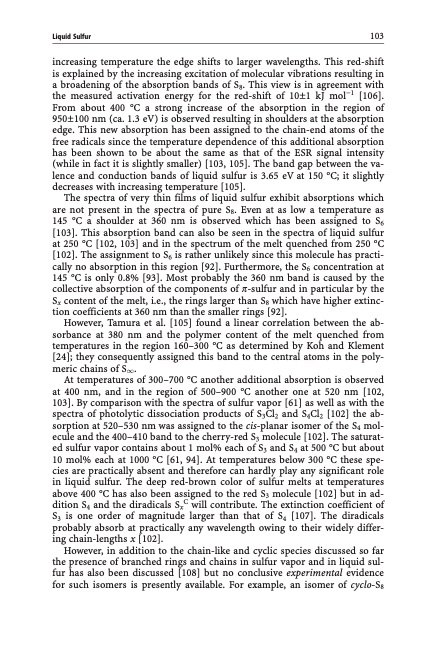
PDF Publication Title:
Text from PDF Page: 113
Liquid Sulfur 103 increasing temperature the edge shifts to larger wavelengths. This red-shift is explained by the increasing excitation of molecular vibrations resulting in a broadening of the absorption bands of S8. This view is in agreement with the measured activation energy for the red-shift of 10€1 kJ mol1 [106]. From about 400 C a strong increase of the absorption in the region of 950€100 nm (ca. 1.3 eV) is observed resulting in shoulders at the absorption edge. This new absorption has been assigned to the chain-end atoms of the free radicals since the temperature dependence of this additional absorption has been shown to be about the same as that of the ESR signal intensity (while in fact it is slightly smaller) [103, 105]. The band gap between the va- lence and conduction bands of liquid sulfur is 3.65 eV at 150 C; it slightly decreases with increasing temperature [105]. The spectra of very thin films of liquid sulfur exhibit absorptions which are not present in the spectra of pure S8. Even at as low a temperature as 145 C a shoulder at 360 nm is observed which has been assigned to S6 [103]. This absorption band can also be seen in the spectra of liquid sulfur at 250 C [102, 103] and in the spectrum of the melt quenched from 250 C [102]. The assignment to S6 is rather unlikely since this molecule has practi- cally no absorption in this region [92]. Furthermore, the S6 concentration at 145 C is only 0.8% [93]. Most probably the 360 nm band is caused by the collective absorption of the components of p-sulfur and in particular by the Sx content of the melt, i.e., the rings larger than S8 which have higher extinc- tion coefficients at 360 nm than the smaller rings [92]. However, Tamura et al. [105] found a linear correlation between the ab- sorbance at 380 nm and the polymer content of the melt quenched from temperatures in the region 160–300 C as determined by Koh and Klement [24]; they consequently assigned this band to the central atoms in the poly- meric chains of S1. At temperatures of 300–700 C another additional absorption is observed at 400 nm, and in the region of 500–900 C another one at 520 nm [102, 103]. By comparison with the spectra of sulfur vapor [61] as well as with the spectra of photolytic dissociation products of S3Cl2 and S4Cl2 [102] the ab- sorption at 520–530 nm was assigned to the cis-planar isomer of the S4 mol- ecule and the 400–410 band to the cherry-red S3 molecule [102]. The saturat- ed sulfur vapor contains about 1 mol% each of S3 and S4 at 500 C but about 10 mol% each at 1000 C [61, 94]. At temperatures below 300 C these spe- cies are practically absent and therefore can hardly play any significant role in liquid sulfur. The deep red-brown color of sulfur melts at temperatures above 400 C has also been assigned to the red S3 molecule [102] but in ad- dition S4 and the diradicals SxC will contribute. The extinction coefficient of S3 is one order of magnitude larger than that of S4 [107]. The diradicals probably absorb at practically any wavelength owing to their widely differ- ing chain-lengths x [102]. However, in addition to the chain-like and cyclic species discussed so far the presence of branched rings and chains in sulfur vapor and in liquid sul- fur has also been discussed [108] but no conclusive experimental evidence for such isomers is presently available. For example, an isomer of cyclo-S8PDF Image | Topics in Current Chemistry

PDF Search Title:
Topics in Current ChemistryOriginal File Name Searched:
Elemental-Sulfur-und-Sulfur-Rich-Compounds-I.pdfDIY PDF Search: Google It | Yahoo | Bing
Sulfur Deposition on Carbon Nanofibers using Supercritical CO2 Sulfur Deposition on Carbon Nanofibers using Supercritical CO2. Gamma sulfur also known as mother of pearl sulfur and nacreous sulfur... More Info
CO2 Organic Rankine Cycle Experimenter Platform The supercritical CO2 phase change system is both a heat pump and organic rankine cycle which can be used for those purposes and as a supercritical extractor for advanced subcritical and supercritical extraction technology. Uses include producing nanoparticles, precious metal CO2 extraction, lithium battery recycling, and other applications... More Info
| CONTACT TEL: 608-238-6001 Email: greg@infinityturbine.com | RSS | AMP |